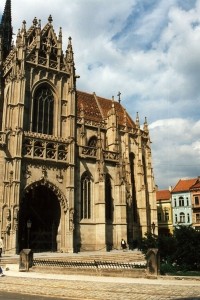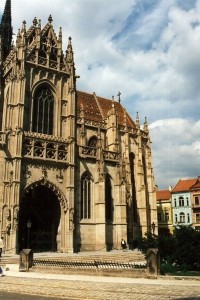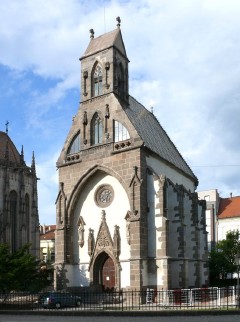Košice Town Conservation Reservation

Košice, the metropolis of eastern Slovakia, is situated on the crossroads of ancient trade roads on the Hornád River in the Košická kotlina Valley. The territory has been settled since the Palaeolithic Age. The first written references to settlement date back to the 13th century. The settlement mentioned in 1230 was on the site of the present-day Slovenská street. After the Tartar invasion of 1241 and 1242 German guests settled in its neighbourhood and soon acquired the first privileges. Stone walls already enclosed the town by 1290 and fairs took place there by the end of the 13th century.
 The resolution and courage of the burghers in defending the independence of Košice against the oligarch Amadé, who had been presented with the town by the monarch at the start of the 14th century, resulted in the goodwill of the victorious King Charles Robert I following the Battle of Rozhanovce. Thereafter the town saw economic growth and benefited from the king´s goodwill in the peaceful years which followed. Among various privileges the most important ones were the privileges of a free royal town granted in 1342. This resulted in rapid economic growth, with Košice becoming the second most important town of the country by the mid 14th century. This position was reflected by the imposing Gothic architecture which was concentrated around the elongated lens-shaped square, including the royal house. Construction of the Gothic Church of St Elizabeth was begun in around 1380 in place of an older church. Stonemasonry works founded during its construction were also engaged in construction work at the royal court. A separate belfry and Chapel of St Michal were built at the church. The most interesting element in the interior is the main wing altar, which dates from the last quarter of the 15th century. It is the biggest altar in Europe due to its 48 Gothic panel paintings. Dominicans and Franciscans had settled in the town in the earlier period and built churches and monasteries at the edges of the town. The Dominican Church is the oldest sacral monument in Košice.
The resolution and courage of the burghers in defending the independence of Košice against the oligarch Amadé, who had been presented with the town by the monarch at the start of the 14th century, resulted in the goodwill of the victorious King Charles Robert I following the Battle of Rozhanovce. Thereafter the town saw economic growth and benefited from the king´s goodwill in the peaceful years which followed. Among various privileges the most important ones were the privileges of a free royal town granted in 1342. This resulted in rapid economic growth, with Košice becoming the second most important town of the country by the mid 14th century. This position was reflected by the imposing Gothic architecture which was concentrated around the elongated lens-shaped square, including the royal house. Construction of the Gothic Church of St Elizabeth was begun in around 1380 in place of an older church. Stonemasonry works founded during its construction were also engaged in construction work at the royal court. A separate belfry and Chapel of St Michal were built at the church. The most interesting element in the interior is the main wing altar, which dates from the last quarter of the 15th century. It is the biggest altar in Europe due to its 48 Gothic panel paintings. Dominicans and Franciscans had settled in the town in the earlier period and built churches and monasteries at the edges of the town. The Dominican Church is the oldest sacral monument in Košice.
The town saw rapid growth of crafts during this period and the first reference to guild regulations in Slovakia comes from Košice. In 1369 King Louis I granted a municipal coat of arms to Košice, the first town in Europe to be given this honour. The town also took the most important position in the Pentapolitana association of eastern Slovak royal towns. It was the seat of a royal chamber, tax office and salt chamber. The exceptional status of the town was reflected in the renovation of burgher houses and particularly in the construction of the dome. The developments of this period are illustrated by the 15th-century house called Levočský dom, which Palatine Alexius Thurzo donated to his native town of Levoča in 1542.
 After the battle at Mohács in 1526 Košice became the centre of the anti-Turkish defence of the Potisie region. Aristocrats and church dignitaries from the occupied southern regions now moved to Košice. However, the state of war unfavourably affected the town's once flourishing trade. A devastating fire in 1556 completed the decay when a large part of the town was burned to ashes. Direct support from the court helped with its fast renovation in Renaissance style. Subsequently the town fortifications were modernised to such an extent that the town changed into an almost impregnable fortress in the 16th and 17th centuries. In addition to the state and military administration and the Spiš Chamber, Košice was also the seat of Archbishop of Eger. The following period of anti-Habsburg rebellions, along with further devastating fires, impacted unfavourably on the development of Košice. However, in spite of the decay, the Jesuit University was founded in the town and in 1660 the monarch granted it rights equal to those of other European universities. The Jesuit University Church with its two towers was built for the university at the end of the 17th century.
After the battle at Mohács in 1526 Košice became the centre of the anti-Turkish defence of the Potisie region. Aristocrats and church dignitaries from the occupied southern regions now moved to Košice. However, the state of war unfavourably affected the town's once flourishing trade. A devastating fire in 1556 completed the decay when a large part of the town was burned to ashes. Direct support from the court helped with its fast renovation in Renaissance style. Subsequently the town fortifications were modernised to such an extent that the town changed into an almost impregnable fortress in the 16th and 17th centuries. In addition to the state and military administration and the Spiš Chamber, Košice was also the seat of Archbishop of Eger. The following period of anti-Habsburg rebellions, along with further devastating fires, impacted unfavourably on the development of Košice. However, in spite of the decay, the Jesuit University was founded in the town and in 1660 the monarch granted it rights equal to those of other European universities. The Jesuit University Church with its two towers was built for the university at the end of the 17th century.
The period after 1711, beginning with the Szatmár Peace and lasting until the revolutionary year of 1848, was a period of peace and growth for Košice, during which the appearance of the town underwent remarkable changes as the aristocracy and burghers rebuilt their palaces in the Baroque and Classicist spirit. In this period several interesting buildings were founded or renovated on the square: the building of the former Town Hall from the second half of the 18th century, the former Župný dom (County House) from 1779, Csáky-Dessewffy Palace from the first half of the 19th century, and the Baroque-Classicist Rákoczi Palace and the Empire Forgách Palace in the later 19th century.
During this period substantial parts of the town fortifications gradually ceased to exist and new suburbs began to grow. A bishopric was established in Košice in 1804 and the dome, rebuilt in the Neo-Gothic style in the end of the 19th century, became the cathedral housing a multitude of unique artistic and architectural achievements. Opposite the dome the Classicist Bishop´s Palace was built in 1804. The remarkable Calvary area was also established. Development received new stimulus in 1860 in the form of a railway connecting Košice with Budapest. The opening of the Košice-Bohumín railway line in 1870 gave fresh economic impetus to the industrial revolution that already got underway here. In the expanding town Jews built their synagogue in the Moorish style in 1883. Imposing Reduta and theatre buildings were constructed in the very centre of the town at the end of the 19th century. Among the most noteworthy Art Nouveau-Romantic buildings of this period was the independently-constructed Jakab's Palace, which utilised stones destined for the reconstruction of the cathedral.
The town also grew in the 20th century when it became an important administrative centre. At this time the construction of new housing estates took place outside the perimeter of the historic core.
Present-day Košice with its large historic area was declared a Town Conservation Reservation in 1983 in deference to the many unique architectonic features which reflect the town's rich history and unique position in the country.
